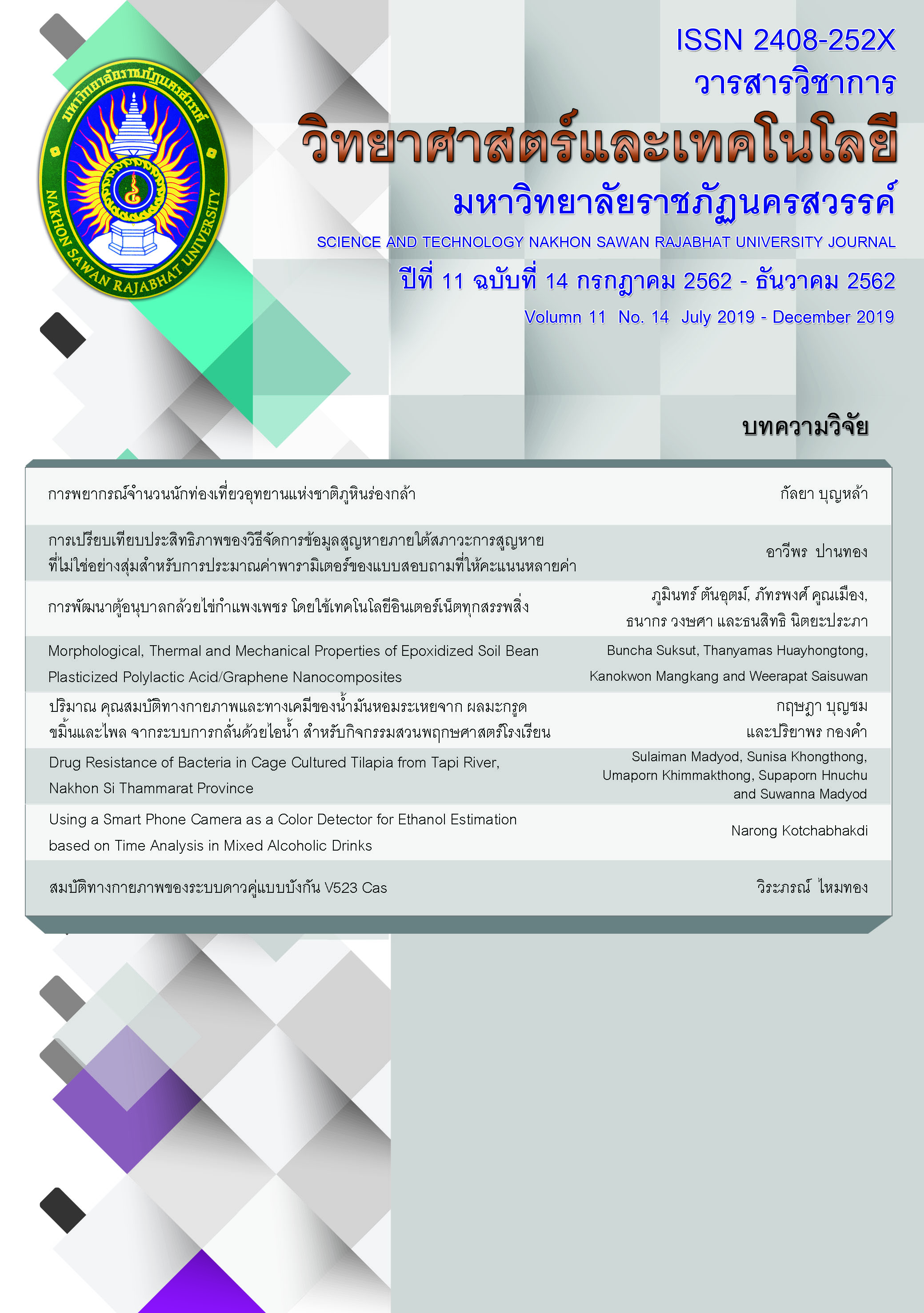Morphological, Thermal and Mechanical Properties of Epoxidized Soil Bean Plasticized Polylactic Acid/Graphene Nanocomposites
Keywords:
biopolymer, bioplasticizer, graphene, crystallizationAbstract
Due to their biodegradability, both polylactic acid (PLA) and epoxidized soil bean (ESO) were blended at various contents of ESO (3-10 wt%) by melt blending in an internal mixer. Inclusion of 10 wt% of ESO into PLA showed the highest elongation at break and the impact strength. The incorporation of graphene (GP) into PLA/ESO blend promoted the impact strength of the composites accompanied by lowering stiffness and strength. From DSC analysis, the glass transition temperature (Tg) decreased, while the degree of crystallinity of PLA increased with the inclusion of ESO. Crystallization temperature (Tc) of PLA at 10 wt% of ESO decreased about 10°C in comparison with neat PLA. However, the presence of GP has no significant effect on any transition temperatures of PLA, but led to smaller spherulite size. The resulting performances of the plasticized PLA composite were explained by two possibilities, the interfacial adhesion between PLA matrix and GP particles as well as the competitive effect of ESO and GP on PLA crystallization.
References
Al-Mulla, E.A.J., Suhail, A.H. & Aowda, S.A. (2011).New biopolymer nanocomposites based on epoxidized soybean oil plasticized poly(lactic acid)/fatty nitrogen compounds modified clay: Preparation and characterization. Industrial Crops and Products, 33(1), 23–29.
Ali, F., Chang, Y.W., Kang, S.C., & Yoon, J.Y. (2009). Thermal, mechanical and rheological properties of poly(lactic acid)/epoxidized soybean oil blends. Polymer Bulletin, 62(1), 91–98.
Arfat, Y.A., Ahmed, J., Ejaz, M. & Mullah, M. (2018). Polylactide/graphene oxide nanosheets/clove essential oil composite films for potential food packaging applications. International Journal of Biological Macromolecules, 107(PtA), 194–203.
Chieng, B.W., Ibrahim, N.A., Yunus, W.M.Z.W., Hussein, M.Z. & Silverajah, V.S.G. (2012). Graphene nanoplatelets as novel reinforcement filler in poly(lactic acid)/epoxidized palm oil green nanocomposites: Mechanical properties. International Journal of Molecular Sciences, 13(9), 10920-10934.
Chieng, B.W., Ibrahim, N.A., Yunus, W.M.Z.W., Hussein, M.Z., Then, Y.Y. & Loo, Y.Y. (2015). Reinforcement of graphene nanoplatelets on plasticized poly(lactic acid) nanocomposites: Mechanical, thermal, morphology, and antibacterial properties. Journal of Applied Polymer Science, 132(11), 1-5.
Fu, S.Y., Feng, X.Q., Lauke, B., & Mai Y.W. (2008). Effects of particle size, particle/matrix interface adhesion and particle loading on mechanical properties of particulate-polymer composites. Composites: Part B 39, 933-961.
He, Y. & Inoue, Y. (2003). α-Cyclodextrin-Enhanced Crystallization of Poly(3- Hydroxybutyrate), Biomacromolecules, 4(6),1865-1867.
Hu, Y., Hu, Y.S., Topolkaraev, V., Hiltner, A. & Bare, E. (2003). Crystallization and phase separation in blends of high stereoregular poly(lactide) with poly(ethylene glycol). Polymer, 44(19), 5681–5689.
Jiang, L., Wolcott, M.P. & Zhang, J. (2006). Study of biodegradable polylactide/poly(butylene adipate-co-terephthalate) blends. Biomacromolecules, 7(1), 199-207.
Labrecque, L.V., Kumar, R.A., Davé, V., Gross, R.A. & Mccarthy, S.P. (1997). Citrate Esters as Plasticizers for Poly (lactic acid). Journal of Applied Polymer Science, 66(8), 1507–1513.
Meng, X., Bocharova, V., Tekinalp, H., Cheng, S., Kisliuk, A., Sokolov, A. P., Kunc, V. Peter, W. H. & Ozcan, S. (2018). Toughening of nanocelluose/PLA composites via bio-epoxy interaction: Mechanistic study. Materials and Design, 139, 188–197.
Nijenhuis, A.J., Colstee, E., Grijpma, D.W. & Pennings, A.J. (1996). High molecular weight poly(-lactide) and poly(ethylene oxide) blends: thermal characterization and physical properties. Polymer, 37(26), 5849-5857.
Piorkowska, E., Kulinski, Z., Galeski, A. & Masirek, R. (2006). Plasticization of semicrystalline poly(L-lactide) with poly(propylene glycol). Polymer, 47(20), 7178-7188.
Popli, R. & Mandelkern, L. (1987). Influence of structural and morphological factors on the mechanical properties of the polyethylenes. Journal of Polymer Science: Part B: Polymer Physics, 25(3), 441-483.
Sarasua, J.R., Prud’homme, R.E., Wisniewski, M., Borgne, A.L. & Spassky, N. (1998). Crystallization and melting behavior of polylactides. Macromolecules, 31(12), 3895-3905.
Sriprachuabwong, C., Duangsripat, S., Sajjaanantakul, K., Wisitsoraat, A. & Tuantranont, A. (2015). Electrolytically exfoliated graphene–polylactide-based bioplastic with high elastic performance. Journal of Applied Polymer Science, 132(6), 1-8.
Suksut, B. & Deeprasertkul, C. (2011). Effect of nucleating agents on physical properties of poly(lactic acid) and Its blend with natural rubber. Journal of Polymers and the Environment, 19(1), 288–296.
Tsuji, H. & Ikada, Y. (1996). Blends of isotactic and atactic poly(lactide)s: 2. Molecular-weight effects of atactic component on crystallization and morphology of equimolar blends from the melt. Polymer, 37(4), 595-602.
Wypych, G. (2012). Handbook of Plasticizers (2nd. ed.). Toronto: ChemTec.
Yokohara, T. & Yamaguchi, M. (2008). Structure and properties for biomass-based polyester blends of PLA and PBS. European Polymer Journal, 44(3), 677-685.
Zhao, X., Zhang, Q., Chen, D. & Lu, P. (2010). Enhanced mechanical properties of graphene-based poly(vinyl alcohol) composites. Macromolecules, 43(5), 2357-2363.



